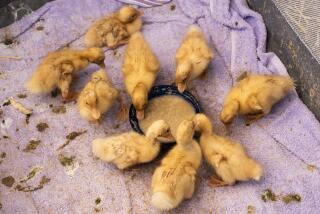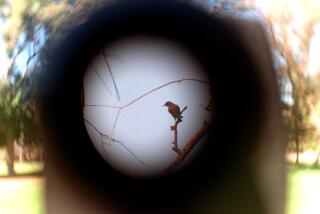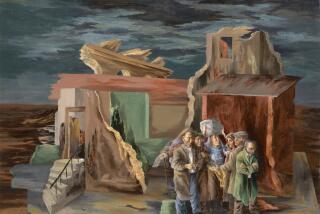Waterfowl, art and obsession collide in ‘The Wild Duck Chase’
“Ice Road Truckers.” “Amish in the City.” “Half Pint Brawlers.” “Federal Duck Stamp Contest Artists.”
If the question were “Which subset of society doesn’t have its own reality TV show?” and you picked duck stamp artists, you’d be correct. But they do come under some scrutiny in an unorthodox little book, “The Wild Duck Chase: Inside the Strange and Wonderful World of the Federal Duck Stamp Contest” (Walker: 262 pp., $25). Author Martin J. Smith thoroughly examines the only juried arts competition run by the federal government, and the artists, judges, hunters and other hangers-on who participate.
You might not envision a copy of “The Wild Duck Chase” on your bedside table. After all, it’s a book about waterfowl and wildlife painting, an artistic genre whose popularity undoubtedly peaked in the 19th century. The rock stars of this particular universe agonize over the details of tail feathers and spend their spare time photographing birds in the wilds of Minnesota. There’s no prize money involved. The victor wins the privilege of having his or her image grace a federal stamp that hunters over the age 16 are required to purchase every year.
But the impassioned efforts of those who populate this oddball community also pay for a program that has, since its inception in 1934, helped raise more than $750 million, most of which has been designated to preserve 5.3 million acres of wetlands and other habitat as part of the National Wildlife Refuge System.
The Federal Duck Stamp Program, Smith suggests, “might restore your faith in the often ineffective and inefficient U.S. government.”
If that doesn’t reel you in, perhaps the promise of fierce sibling rivalry, shocking emotional roller-coasters and a brush with pornography will do the trick.
Not surprisingly, Smith’s writing style calls to mind a number of nonfiction narratives written by former denizens of the daily newspaper world. He’s a former L.A. Times editor and chronicler of pop culture and current events (previous titles include “Poplorica” and “Oops: 20 Life Lessons from the Fiascoes That Shaped America”).
His dive into the world of competitive duck painting is deep. Chapters on artists and contest rules and the 2010 competition, held in Berkeley, are interspersed with a detailed history of the duck stamp program. And Smith is clearly enamored with the results.
“Without preserves,” Smith writes, “commercial hunters and profiteers with increasingly efficient killing methods would have continued to decimate America’s waterfowl populations, as they did through most of the 18th and 19th centuries, often for such frivolous reasons as the Victorian-era demand for ladies’ hats festooned with the brightly colored plumes of various species.”
Smith throws in a few statistics on bird deaths (cats and crashing into windows are a problem) and acknowledges a general decline of interest in all things outdoors. He reminds us that the duck stamp contest is referenced in “Fargo,” that the writing-directing Coen brothers grew up in Minnesota, home to several winners and a spectacular geography that is conducive to waterfowl recreation. (The Coen brothers were childhood friends with the fabled Hautman brothers, who have won a total of 10 contests.)
Indeed, it is the artists who prove to be the strangest, most charming characters in “Chase.” How strange? In April 2010, a visitor discovers that artist Bob Hautman has 15 dead birds in his freezer. “Some of them he shot himself; others were gifts. A few blundered into his studio’s sliding glass door.”
Another artist, Rob McBroom, adorns his paintings with glitter, rhinestones and corporate logos, “and in 2001, a scorchingly filthy monologue from a porn movie translated into Morse code and disguised as rain falling on a black scooter.”
Participation borders on and, frequently, merges with obsession. (It should be noted that despite the absence of prize money, winners do stand to make a bundle, thanks to appearances, festivals and licensing deals.)
And obsession makes for a surprisingly compelling read.
ALSO:
Avert your eyes! A gallery of banned and challenged books
MacArthur genius fellows include Junot Diaz and Dinaw Mengetsu
In ‘Total Recall: My Unbelievably True Life Story,’ Arnold Schwarzenegger holds back
More to Read
Sign up for our Book Club newsletter
Get the latest news, events and more from the Los Angeles Times Book Club, and help us get L.A. reading and talking.
You may occasionally receive promotional content from the Los Angeles Times.










